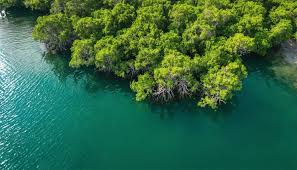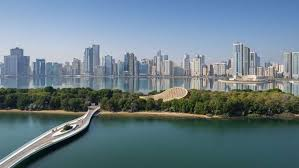Now Reading: How Mangroves Secretly Fight Climate Change by Trapping Tons of Carbon 2025
-
01
How Mangroves Secretly Fight Climate Change by Trapping Tons of Carbon 2025
How Mangroves Secretly Fight Climate Change by Trapping Tons of Carbon 2025

Table of Contents
In the fight against climate change, mangroves are turning out to be one of nature’s most powerful and underrated heroes. While forests and oceans have long been praised for capturing harmful carbon dioxide (CO2) from the atmosphere, new research shows that mangroves do this job far more efficiently than many other ecosystems.
But what makes these coastal trees so special? And how exactly do they help protect the earth from the growing threat of global warming? Let’s explore the amazing role of mangroves in carbon capture and why saving them is crucial for our future.
What Is Carbon Capture?

Carbon capture refers to the process of removing CO2—a greenhouse gas—from the atmosphere and storing it so it cannot contribute to global warming. Typically, this happens naturally when plants absorb CO2 during photosynthesis and store it in their roots, stems, and leaves. Scientists call this process “carbon sequestration.”
Artificial carbon capture technologies, like carbon storage plants, are being developed worldwide. However, these methods are often expensive, energy-hungry, and not always reliable. This is where nature steps in—with mangroves leading the way.
Why Mangroves Are Excellent at Carbon Capture

Mangroves are special coastal trees that grow in salty, waterlogged environments, mainly in tropical and subtropical regions. These forests may look small compared to giant rainforests, but they are mighty when it comes to storing carbon.
Here’s why:
- Superb Storage Ability:
Mangroves can store carbon not only in their leaves and trunks but also deep in the soil. In fact, up to 80% of the carbon captured by mangroves is trapped below ground in their muddy, oxygen-poor soil. This carbon can stay locked away for hundreds or even thousands of years. - Higher Capture Rate Than Rainforests:
Studies show that mangroves can capture carbon up to four times faster than tropical rainforests. This makes them a “carbon sink”—a natural storage place that keeps carbon out of the atmosphere far more effectively than other ecosystems. - Resilient to Harsh Conditions:
Mangroves survive floods, saltwater, and extreme temperatures, meaning they continue to capture carbon even when conditions are tough. This makes them reliable allies in the battle against climate change.
The Global Importance of Mangroves
Mangroves cover just 0.1% of the planet’s surface, but they punch well above their weight in carbon storage. Scientists estimate that mangrove forests absorb more than 10 billion kilograms of CO2 every year. If all the carbon stored in the world’s mangroves were released at once, it would be equal to the annual emissions of over 600 million cars.
Countries like Indonesia, India, Brazil, and Australia are home to large mangrove forests. Protecting these areas is now seen as a top priority not only for fighting climate change but also for protecting biodiversity and supporting coastal communities.
Benefits Beyond Carbon Capture
Mangroves do more than just trap carbon. They also:
- Protect coastlines from storms and floods by acting as natural barriers.
- Support marine life, providing shelter for fish, crabs, and shrimp.
- Improve water quality by filtering pollutants and trapping sediments.
- Offer livelihoods to millions of people who depend on fishing and eco-tourism.
This multi-purpose value makes mangroves an important focus for environmental programs worldwide.
Threats to Mangrove Forests
Despite their value, mangroves are under threat. Human activities like shrimp farming, coastal development, and pollution are destroying mangrove habitats at alarming rates. Over the last 50 years, nearly 35% of the world’s mangroves have disappeared.
When mangroves are cut down, not only is their carbon storage ability lost, but the carbon stored in their soil is also released—adding to the very problem of global warming that they are meant to solve.
Global Efforts to Save Mangroves
Thankfully, governments, scientists, and organizations are taking action. Projects like “Blue Carbon Initiatives” are focusing on preserving and restoring mangrove forests. The term “blue carbon” refers to carbon stored in ocean and coastal ecosystems like mangroves, seagrasses, and salt marshes.
The United Nations, World Bank, and local governments are funding mangrove restoration in countries like Kenya, Bangladesh, and Mexico. In the UAE, large-scale mangrove planting is part of the country’s strategy to meet climate goals.
In India, the Sundarbans—the world’s largest mangrove forest—is now a protected area, helping preserve this vital ecosystem for future generations.
How You Can Help
Even individuals can make a difference:
- Support organizations that protect and restore mangroves.
- Reduce seafood consumption from sources linked to mangrove destruction.
- Raise awareness about the importance of mangroves in schools, communities, and social media.
- Participate in coastal clean-up drives to keep mangrove areas free of trash and pollution.
Conclusion: A Natural Solution to a Global Problem
In a world struggling with the impacts of climate change, mangroves offer a simple yet powerful solution. They naturally trap large amounts of carbon, protect coastlines, and support biodiversity. But these “green guardians” cannot protect the planet if they are not protected themselves.
Saving mangroves is not just good for nature—it is good for humanity, the climate, and future generations. By investing in these coastal forests, the world can take an important step toward a cleaner, safer, and more sustainable future.
Read More:- Shobha Realty Launches Its Most Luxurious Project Yet—Full Details Inside 2025





















